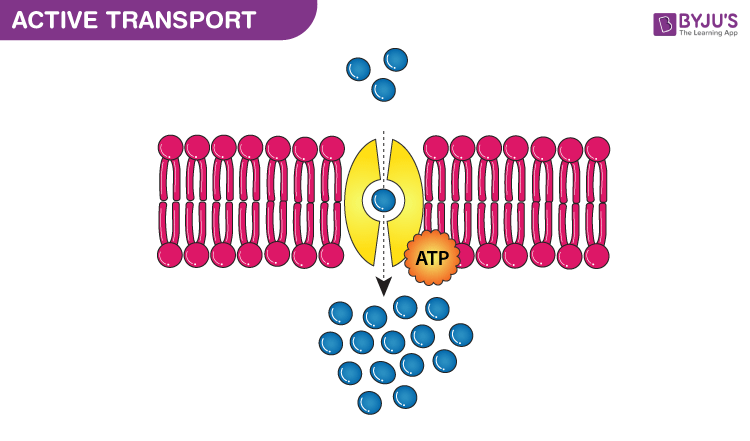Transportation is an essential, natural and the physiological process which occurs in all the higher organisms including plants, animals, and humans. In order to sustain life, this process is important as it functions by constantly transporting, different essential materials to and from all parts of the body including cells, tissues, and organs.
The essential materials mainly include water, hormones, gases, mineral nutrition, organic material, etc. The different means of transport in a living organism are:
- Diffusion
- Facilitated diffusion
- Active transport
- Passive transport.
Also, read Transportation In Plants
Let us have a detailed overview of Active transport.
What is Active Transport?
“Active Transport is defined as a process that involves the movement of molecules from a region of lower concentration to a region of higher concentration against a gradient or an obstacle with the use of external energy.”
During the process of active transport, a protein pump makes use of stored energy in the form of ATP, to move molecules
The below diagram shows the process of active transport, which uses an external energy ATP for the movement of the molecules.

Active Transport
The uptake of glucose in the intestine of the human body and also the uptake of minerals or ions into the root hair cells of the plants are some of the examples of active transport.
Types of Active transport
There are two types of active transport namely – Primary active transport and secondary active transport.
Primary active transport
In this process of transportation, the energy is utilized by the breakdown of the ATP – Adenosine triphosphate to transport molecules across the membrane against a concentration gradient. Therefore, all the groups of ATP powered pumps contain one or more binding sites for the ATP molecules, which are present on the cytosolic face of the membrane. Basically, the primary active transport uses external chemical energy such as the ATP.
Sodium-potassium pump, the most important pump in the animal cell is considered as an example of primary active transport. In this process of transportation, the sodium ions are moved to the outside of the cell and potassium ions are moved to the inside of the cell.
Secondary active transport
Secondary active transport is a kind of active transport that uses electrochemical energy. It takes place across a biological membrane where a transporter protein couples the movement of an electrochemical ion (typically Na+ or H+) down its electrochemical gradient to the upward movement of another molecule or an ion against a concentration or electrochemical gradient.
Electrochemical Gradient
Electrochemical gradient exists whenever there is a net difference in charges. The positive and negative charges of a cell are separated by a membrane, where the inside of the cell has extra negative charges than outside. The membrane potential of a cell is -40 to -80 millivolts.
The cell has higher potassium concentration inside the cell but lower sodium concentration than the extracellular fluid. The sodium ions will move inside the cell based on the concentration gradient and voltage across the membrane. The voltage across the membrane facilitates the movement of potassium into the cell, but its concentration gradient drives it out of the cell. The combination of voltage across the membrane and the concentration gradient that facilitates the movement of ions is called the electrochemical gradient.
Active Transport in Plants
Like humans and animals, plants also require transport systems which are mainly involved in the transport of materials, such as water, minerals, and necessary nutrients to all parts of the plant for its survival.
Active transport is a mode of transportation in plants, which uses stored energy to move the particles against the concentration gradient. In a plant cell, it takes place in the root cells by absorbing water and minerals. Active transport always leads to accumulation of molecules are ions towards one side of the membrane. This mode of transportation in plants is carried out by membrane proteins and transports the substance from the lower concentration to higher concentration.
Examples of Active Transport
Some of the best examples of active transport include:
- Phagocytosis of bacteria by Macrophages.
- Movement of Ca2+ ions out of cardiac muscle cells.
- Transportation of amino acids across the intestinal lining in the human gut.
- Secretion of proteins like enzymes, peptide hormones, and antibodies from different cells.
- Functioning of the White Blood Cells by protecting our body by attacking diseases causing microbes and other foreign invaders.
Also, read about the Passive Transport
Learn more about Active transport, its types, and other related topics @ BYJU’S Biology

up to date information
is chloride shift active transport?
Chloride shift is passive transport since no ATP is being used.